The Effect of Plant-Based Protein Ingestion on Athletic Ability in Healthy People—A Bayesian Meta-Analysis with Systematic Review of Randomized Controlled Trials
Abstract
1. Key Points
2. Background
3. Methods
3.1. Search Strategy
3.2. Inclusion and Exclusion Criteria
3.3. Selection Process
3.4. Risk of Bias Assessment
3.5. Certainty in Evidence
3.6. Data Extraction
3.7. Summary Measures and Synthesis
3.8. Subgroup Analysis
4. Results
4.1. Study Characteristics
4.2. Risk of Bias of Included Studies
4.3. Quality Grade in Each Outcome
4.4. Convergence of the Markov Chain
4.5. Meta-Analysis
4.5.1. Results of Plant-Based Protein vs. No Protein
4.5.2. Results of Plant-Based Protein vs. Other Types of Protein
4.5.3. Subgroup Analysis
4.5.4. Subgroup Analysis Based on Types of Athletic Performance
4.5.5. Subgroup Analysis Based on Age
4.6. Risk of Bias (Funnel Plots)
4.6.1. Results of Plant-Based Protein vs. No Protein
4.6.2. Results of Plant-Based Protein vs. Other Types of Protein
5. Discussion
5.1. Plant-Based Protein vs. No Protein
5.2. Plant-Based Protein vs. Other Types of Protein
6. Strengths and Limitations
7. Conclusions
Supplementary Materials
Author Contributions
Funding
Data Availability Statement
Conflicts of Interest
Abbreviations
References
- National Strength & Conditioning Association (U.S.); Campbell, B.I.; Spano, M.A. (Eds.) NSCA’s Guide to Sport and Exercise Nutrition; Science of Strength and Conditioning Series; Human Kinetics: Champaign, IL, USA, 2011. [Google Scholar]
- Haub, M.D.; Wells, A.M.; Campbell, W.W. Beef and Soy-Based Food Supplements Differentially Affect Serum Lipoprotein-Lipid Profiles Because of Changes in Carbohydrate Intake and Novel Nutrient Intake Ratios in Older Men Who Resistive-Train. Metabolism 2005, 54, 769–774. [Google Scholar] [CrossRef] [PubMed]
- Candow, D.G.; Burke, N.C.; Smith-Palmer, T.; Burke, D.G. Effect of Whey and Soy Protein Supplementation Combined with Resistance Training in Young Adults. Int. J. Sport Nutr. Exerc. Metab. 2006, 16, 233–244. [Google Scholar] [CrossRef] [PubMed]
- Joy, J.M.; Lowery, R.P.; Wilson, J.M.; Purpura, M.; De Souza, E.O.; Wilson, S.M.; Kalman, D.S.; Dudeck, J.E.; Jäger, R. The Effects of 8 Weeks of Whey or Rice Protein Supplementation on Body Composition and Exercise Performance. Nutr. J. 2013, 12, 86. [Google Scholar] [CrossRef] [PubMed]
- Lynch, H.M.; Buman, M.P.; Dickinson, J.M.; Ransdell, L.B.; Johnston, C.S.; Wharton, C.M. No Significant Differences in Muscle Growth and Strength Development When Consuming Soy and Whey Protein Supplements Matched for Leuine Following a 12 Week Resistance Training Program in Men and Women: A Randomized Trial. Int. J. Environ. Res. Public Health 2020, 17, 3871. [Google Scholar] [CrossRef] [PubMed]
- Moon, J.M.; Ratliff, K.M.; Blumkaitis, J.C.; Harty, P.S.; Zabriskie, H.A.; Stecker, R.A.; Currier, B.S.; Jagim, A.R.; Jäger, R.; Purpura, M.; et al. Effects of Daily 24-Gram Doses of Rice or Whey Protein on Resistance Training Adaptations in Trained Males. J. Int. Soc. Sports Nutr. 2020, 17, 60. [Google Scholar] [CrossRef] [PubMed]
- Loureiro, L.L.; Ferreira, T.J.; Cahuê, F.L.C.; Bittencourt, V.Z.; Valente, A.P.; Pierucci, A.P.T.R. Comparison of the Effects of Pea Protein and Whey Protein on the Metabolic Profile of Soccer Athletes: A Randomized, Double-Blind, Crossover Trial. Front. Nutr. 2023, 10, 1210215. [Google Scholar] [CrossRef] [PubMed]
- Ghosh, A.K.; Rahaman, A.A.; Singh, R. Combination of Sago and Soy-Protein Supplementation During Endurance Cycling Exercise and Subsequent High-Intensity Endurance Capacity. Int. J. Sport Nutr. Exerc. Metab. 2010, 20, 216–223. [Google Scholar] [CrossRef] [PubMed]
- Bartholomae, E.; Incollingo, A.; Vizcaino, M.; Wharton, C.; Johnston, C.S. Mung Bean Protein Supplement Improves Muscular Strength in Healthy, Underactive Vegetarian Adults. Nutrients 2019, 11, 2423. [Google Scholar] [CrossRef]
- Bijeh, N.; Mohammadnia-Ahmadi, M.; Hooshamnd-Moghadam, B.; Eskandari, M.; Golestani, F. Effects of Soy Milk in Conjunction With Resistance Training on Physical Performance and Skeletal Muscle Regulatory Markers in Older Men. Biol. Res. Nurs. 2022, 24, 294–307. [Google Scholar] [CrossRef] [PubMed]
- Oikawa, S.Y.; Bahniwal, R.; Holloway, T.M.; Lim, C.; McLeod, J.C.; McGlory, C.; Baker, S.K.; Phillips, S.M. Potato Protein Isolate Stimulates Muscle Protein Synthesis at Rest and with Resistance Exercise in Young Women. Nutrients 2020, 12, 1235. [Google Scholar] [CrossRef]
- Pinckaers, P.J.M.; Hendriks, F.K.; Hermans, W.J.H.; Goessens, J.P.B.; Senden, J.M.; Van Kranenburg, J.M.X.; Wodzig, W.K.H.W.; Snijders, T.; Van Loon, L.J.C. Potato Protein Ingestion Increases Muscle Protein Synthesis Rates at Rest and during Recovery from Exercise in Humans. Med. Sci. Sports Exerc. 2022, 54, 1572–1581. [Google Scholar] [CrossRef] [PubMed]
- Van Der Heijden, I.; Monteyne, A.J.; West, S.; Morton, J.P.; Langan-Evans, C.; Hearris, M.A.; Abdelrahman, D.R.; Murton, A.J.; Stephens, F.B.; Wall, B.T. Plant Protein Blend Ingestion Stimulates Post-Exercise Myofibrillar Protein Synthesis Rates Equivalently to Whey in Resistance-Trained Adults. Med. Sci. Sports Exerc. 2024, 56, 1467–1479. [Google Scholar] [CrossRef]
- West, S.; Monteyne, A.J.; Whelehan, G.; Van Der Heijden, I.; Abdelrahman, D.R.; Murton, A.J.; Finnigan, T.J.A.; Stephens, F.B.; Wall, B.T. Ingestion of Mycoprotein, Pea Protein, and Their Blend Support Comparable Postexercise Myofibrillar Protein Synthesis Rates in Resistance-Trained Individuals. Am. J. Physiol.-Endocrinol. Metab. 2023, 325, E267–E279. [Google Scholar] [CrossRef]
- Kouw, I.W.K.; Pinckaers, P.J.M.; Le Bourgot, C.; Van Kranenburg, J.M.X.; Zorenc, A.H.; De Groot, L.C.P.G.M.; Verdijk, L.; Snijders, T.; Van Loon, L.J.C. Ingestion of an Ample Amount of Meat Substitute Based on a Lysine-Enriched, Plant-Based Protein Blend Stimulates Postprandial Muscle Protein Synthesis to a Similar Extent as an Isonitrogenous Amount of Chicken in Healthy, Young Men. Br. J. Nutr. 2022, 128, 1955–1965. [Google Scholar] [CrossRef]
- McKendry Lowisz, C.V.; Nanthakumar, A.; MacDonald, M.; Lim, C.; Currier, B.S.; Phillips, S.M. The effects of whey, pea, and collagen protein supplementation beyond the recommended dietary allowance on integrated myofibrillar protein synthetic rates in older males: A randomized controlled trial. Am. J. Clin. Nutr. 2024, 120, 34–46. [Google Scholar] [CrossRef] [PubMed]
- Li Fang, A.; Ma, W.; Wu, S.; Li, C.; Chen, Y.; Zhu, H. Amount Rather than Animal vs Plant Protein Intake Is Associated with Skeletal Muscle Mass in Community-Dwelling Middle-Aged and Older Chinese Adults: Results from the Guangzhou Nutrition and Health Study. J. Acad. Nutr. Diet. 2019, 119, 1501–1510. [Google Scholar] [CrossRef]
- Van Vliet, S.; Burd, N.A.; Van Loon, L.J. The Skeletal Muscle Anabolic Response to Plant- versus Animal-Based Protein Consumption. J. Nutr. 2015, 145, 1981–1991. [Google Scholar] [CrossRef] [PubMed]
- López-Martínez, M.I.; Miguel, M.; Garcés-Rimón, M. Protein and Sport: Alternative Sources and Strategies for Bioactive and Sustainable Sports Nutrition. Front. Nutr. 2022, 9, 926043. [Google Scholar] [CrossRef] [PubMed]
- Pinckaers, P.J.M.; Kouw, I.W.K.; Hendriks, F.K.; Van Kranenburg, J.M.X.; De Groot, L.C.P.G.M.; Verdijk, L.B.; Snijders, T.; Van Loon, L.J.C. No Differences in Muscle Protein Synthesis Rates Following Ingestion of Wheat Protein, Milk Protein, and Their Protein Blend in Healthy, Young Males. Br. J. Nutr. 2021, 126, 1832–1842. [Google Scholar] [CrossRef]
- Wirth, J.; Segat, A.; Horner, K.; Crognale, D.; Smith, T.; O’Sullivan, M.; Brennan, L. Impact of Increased Protein Intake in Older Adults: A 12-Week Double-Blind Randomised Controlled Trial. Age Ageing 2024, 53 (Suppl. S2), ii13–ii19. [Google Scholar] [CrossRef]
- Reidy, P.T.; Borack, M.S.; Markofski, M.M.; Dickinson, J.M.; Deer, R.R.; Husaini, S.H.; Walker, D.K.; Igbinigie, S.; Robertson, S.M.; Cope, M.B.; et al. Protein Supplementation Has Minimal Effects on Muscle Adaptations during Resistance Exercise Training in Young Men: A Double-Blind Randomized Clinical Trial. J. Nutr. 2016, 146, 1660–1669. [Google Scholar] [CrossRef]
- Teixeira, F.J.; Matias, C.N.; Faleiro, J.; Giro, R.; Pires, J.; Figueiredo, H.; Carvalhinho, R.; Monteiro, C.P.; Reis, J.F.; Valamatos, M.J.; et al. A Novel Plant-Based Protein Has Similar Effects Compared to Whey Protein on Body Composition, Strength, Power, and Aerobic Performance in Professional and Semi-Professional Futsal Players. Front. Nutr. 2022, 9, 934438. [Google Scholar] [CrossRef] [PubMed]
- Jentjens, R.L.P.G.; Van Loon, L.J.C.; Mann, C.H.; Wagenmakers, A.J.M.; Jeukendrup, A.E. Addition of Protein and Amino Acids to Carbohydrates Does Not Enhance Postexercise Muscle Glycogen Synthesis. J. Appl. Physiol. 2001, 91, 839–846. [Google Scholar] [CrossRef] [PubMed]
- Thomson, R.L.; Brinkworth, G.D.; Noakes, M.; Buckley, J.D. Muscle Strength Gains during Resistance Exercise Training Are Attenuated with Soy Compared with Dairy or Usual Protein Intake in Older Adults: A Randomized Controlled Trial. Clin. Nutr. 2016, 35, 27–33. [Google Scholar] [CrossRef] [PubMed]
- Upshaw, A.U.; Wong, T.S.; Bandegan, A.; Lemon, P.W.R. Cycling Time Trial Performance 4 Hours after Glycogen-Lowering Exercise Is Similarly Enhanced by Recovery Nondairy Chocolate Beverages Versus Chocolate Milk. Int. J. Sport Nutr. Exerc. Metab. 2016, 26, 65–70. [Google Scholar] [CrossRef] [PubMed]
- Deibert, P.; Solleder, F.; König, D.; Vitolins, M.Z.; Dickhuth, H.; Gollhofer, A.; Berg, A. Soy Protein Based Supplementation Supports Metabolic Effects of Resistance Training in Previously Untrained Middle Aged Males. Aging Male 2011, 14, 273–279. [Google Scholar] [CrossRef] [PubMed]
- Zare, R.; Devrim-Lanpir, A.; Guazzotti, S.; Ali Redha, A.; Prokopidis, K.; Spadaccini, D.; Cannataro, R.; Cione, E.; Henselmans, M.; Aragon, A.A. Effect of Soy Protein Supplementation on Muscle Adaptations, Metabolic and Antioxidant Status, Hormonal Response, and Exercise Performance of Active Individuals and Athletes: A Systematic Review of Randomised Controlled Trials. Sports Med. 2023, 53, 2417–2446. [Google Scholar] [CrossRef]
- Langyan, S.; Yadava, P.; Khan, F.N.; Dar, Z.A.; Singh, R.; Kumar, A. Sustaining Protein Nutrition Through Plant-Based Foods. Front. Nutr. 2022, 8, 772573. [Google Scholar] [CrossRef] [PubMed]
- Shenoy, S.; Dhawan, M.; Singh Sandhu, J. Four Weeks of Supplementation with Isolated Soy Protein Attenuates Exercise-Induced Muscle Damage and Enhances Muscle Recovery in Well Trained Athletes: A Randomized Trial. Asian J. Sports Med. 2016, 7, e33528. [Google Scholar] [CrossRef] [PubMed]
- Digitizer, G.G. Getdata-Graph-Digitizer. 2020. Available online: https://getdata-graph-digitizer.software.informer.com/download/ (accessed on 30 June 2024).
- Röver, C. Bayesian Random-Effects Meta-Analysis Using the Bayesmeta R Package. J. Stat. Softw. 2020, 93, 1–51. [Google Scholar] [CrossRef]
- Harrer, M.; Cuijpers, P.; Furukawa, T.A.; Ebert, D.D. Doing Meta-Analysis with R: A Hands-On Guide, 1st ed.; Chapman & Hall/CRC Press: Boca Raton, FL, USA, 2021. [Google Scholar] [CrossRef]
- Higgins, J.P.T.; Thompson, S.G.; Spiegelhalter, D.J. A re-evaluation of random-effects meta-analysis. J. R. Stat. Soc. Ser. A (Stat. Soc.) 2009, 172, 137–159. [Google Scholar] [CrossRef]
- Rover, C. Bayesian Random-Effects Meta-Analysis Using the Bayesmeta R Package. arXiv 2018, arXiv:1711.08683. [Google Scholar] [CrossRef]
- Kruschke, J.K.; Liddell, T.M. The Bayesian new statistics: Hypothesis testing, estimation, meta-analysis, and power analysis from a Bayesian perspective. Psychon. Bull. Rev. 2018, 25, 178–206. [Google Scholar] [CrossRef] [PubMed]
- Gelman, A.; Simpson, D.; Betancourt, M. The prior can often only be understood in the context of the likelihood. Entropy 2017, 19, 555. [Google Scholar] [CrossRef]
- Wilkinson, S.B.; Tarnopolsky, M.A.; MacDonald, M.J.; MacDonald, J.R.; Armstrong, D.; Phillips, S.M. Consumption of Fluid Skim Milk Promotes Greater Muscle Protein Accretion after Resistance Exercise than Does Consumption of an Isonitrogenous and Isoenergetic Soy-Protein Beverage. Am. J. Clin. Nutr. 2007, 85, 1031–1040. [Google Scholar] [CrossRef]
- Naclerio, F.; Seijo, M.; Earnest, C.P.; Puente-Fernández, J.; Larumbe-Zabala, E. Ingesting a Post-Workout Vegan-Protein Multi-Ingredient Expedites Recovery after Resistance Training in Trained Young Males. J. Diet. Suppl. 2021, 18, 698–713. [Google Scholar] [CrossRef] [PubMed]
- Kritikos, S.; Papanikolaou, K.; Draganidis, D.; Poulios, A.; Georgakouli, K.; Tsimeas, P.; Tzatzakis, T.; Batsilas, D.; Batrakoulis, A.; Deli, C.K.; et al. Effect of Whey vs. Soy Protein Supplementation on Recovery Kinetics Following Speed Endurance Training in Competitive Male Soccer Players: A Randomized Controlled Trial. J. Int. Soc. Sports Nutr. 2021, 18, 23. [Google Scholar] [CrossRef]
- Laskowski, R.; Antosiewicz, J. Increased Adaptability of Young Judo Sportsmen after Protein Supplementation. J. Sports Med. Phys. Fit. 2003, 43, 342–346. [Google Scholar]
- Pinckaers, P.J.M.; Weijzen, M.E.G.; Houben, L.H.P.; Zorenc, A.H.; Kouw, I.W.K.; De Groot, L.C.P.G.M.; Verdijk, L.B.; Snijders, T.; Van Loon, L.J.C. The Muscle Protein Synthetic Response Following Corn Protein Ingestion Does Not Differ from Milk Protein in Healthy, Young Adults. Amino Acids 2024, 56, 8. [Google Scholar] [CrossRef]
- Davies, R.W.; Kozior, M.; Lynch, A.E.; Bass, J.J.; Atherton, P.J.; Smith, K.; Jakeman, P.M. The Effect of Fava Bean (Vicia faba L.) Protein Ingestion on Myofibrillar Protein Synthesis at Rest and after Resistance Exercise in Healthy, Young Men and Women: A Randomised Control Trial. Nutrients 2022, 14, 3688. [Google Scholar] [CrossRef] [PubMed]
- Fritz, P.; Fritz, R.; Bóday, P.; Bóday, Á.; Bató, E.; Kesserű, P.; Oláh, C. Gut Microbiome Composition: Link between Sports Performance and Protein Absorption? J. Int. Soc. Sports Nutr. 2024, 21, 2297992. [Google Scholar] [CrossRef] [PubMed]
- Pinckaers, P.J.M.; Trommelen, J.; Snijders, T.; Van Loon, L.J.C. The Anabolic Response to Plant-Based Protein Ingestion. Sports Med. 2021, 51 (Suppl. S1), 59–74. [Google Scholar] [CrossRef] [PubMed]
- Subali, D.; Christos, R.; Givianty, V.; Ranti, A.; Kartawidjajaputra, F.; Antono, L.; Dijaya, R.; Taslim, N.; Rizzo, G.; Nurkolis, F. Soy-Based Tempeh Rich in Paraprobiotics Properties as Functional Sports Food: More Than a Protein Source. Nutrients 2023, 15, 2599. [Google Scholar] [CrossRef] [PubMed]
- Berg, A.; Schaffner, D.; Pohlmann, Y.; Baumstark, M.W.; Deibert, P.; König, D.; Gollhofer, A. A Soy-Based Supplement Alters Energy Metabolism but Not the Exercise-Induced Stress Response. Exerc. Immunol. Rev. 2012, 18, 128–141. [Google Scholar] [PubMed]
- Trapp, D.; Knez, W.; Sinclair, W. Could a Vegetarian Diet Reduce Exercise-Induced Oxidative Stress? A Review of the Literature. J. Sports Sci. 2010, 28, 1261–1268. [Google Scholar] [CrossRef] [PubMed]
- Nichele, S.; Phillips, S.M.; Boaventura, B.C.B. Plant-Based Food Patterns to Stimulate Muscle Protein Synthesis and Support Muscle Mass in Humans: A Narrative Review. Appl. Physiol. Nutr. Metab. 2022, 47, 700–710. [Google Scholar] [CrossRef] [PubMed]
- Barnard, N.D.; Goldman, D.M.; Loomis, J.F.; Kahleova, H.; Levin, S.M.; Neabore, S.; Batts, T.C. Plant-Based Diets for Cardiovascular Safety and Performance in Endurance Sports. Nutrients 2019, 11, 130. [Google Scholar] [CrossRef] [PubMed]
- Goldman, D.M.; Warbeck, C.B.; Karlsen, M.C. Protein Requirements for Maximal Muscle Mass and Athletic Performance Are Achieved with Completely Plant-Based Diets Scaled to Meet Energy Needs: A Modeling Study in Professional American Football Players. Nutrients 2024, 16, 1903. [Google Scholar] [CrossRef]
- Babault, N.; Païzis, C.; Deley, G.; Guérin-Deremaux, L.; Saniez, M.-H.; Lefranc-Millot, C.; Allaert, F.A. Pea Proteins Oral Supplementation Promotes Muscle Thickness Gains during Resistance Training: A Double-Blind, Randomized, Placebo-Controlled Clinical Trial vs. Whey Protein. J. Int. Soc. Sports Nutr. 2015, 12, 3. [Google Scholar] [CrossRef]
- Jäger Kerksick, C.M.; Campbell, B.I.; Cribb, P.J.; Wells, S.D.; Skwiat, T.M.; Purpura, M.; Ziegenfuss, T.N.; Ferrando, A.A.; Arent, S.M.; Smith-Ryan, A.E.; et al. International Society of Sports Nutrition Position Stand: Protein and exercise. J. Int. Soc. Sports Nutr. 2017, 14, 20. [Google Scholar] [CrossRef]
- Isenmann, E.; Eggers, L.; Havers, T.; Schalla, J.; Lesch, A.; Geisler, S. Change to a Plant-Based Diet Has No Effect on Strength Performance in Trained Persons in the First 8 Weeks—A 16-Week Controlled Pilot Study. Int. J. Environ. Res. Public Health 2023, 20, 1856. [Google Scholar] [CrossRef]
- Tessari, P.; Lante, A.; Mosca, G. Essential Amino Acids: Master Regulators of Nutrition and Environmental Footprint? Sci. Rep. 2016, 6, 26074. [Google Scholar] [CrossRef] [PubMed]
- Hevia-Larraín, V.; Gualano, B.; Longobardi, I.; Gil, S.; Fernandes, A.L.; Costa, L.A.R.; Pereira, R.M.R.; Artioli, G.G.; Phillips, S.M.; Roschel, H. High-Protein Plant-Based Diet Versus a Protein-Matched Omnivorous Diet to Support Resistance Training Adaptations: A Comparison Between Habitual Vegans and Omnivores. Sports Med. 2021, 51, 1317–1330. [Google Scholar] [CrossRef] [PubMed]
- Lim, M.T.; Pan, B.J.; Toh, D.W.K.; Sutanto, C.N.; Kim, J.E. Animal Protein versus Plant Protein in Supporting Lean Mass and Muscle Strength: A Systematic Review and Meta-Analysis of Randomized Controlled Trials. Nutrients 2021, 13, 661. [Google Scholar] [CrossRef] [PubMed]
- Messina, M.; Lynch, H.; Dickinson, J.M.; Reed, K.E. No Difference Between the Effects of Supplementing With Soy Protein Versus Animal Protein on Gains in Muscle Mass and Strength in Response to Resistance Exercise. Int. J. Sport Nutr. Exerc. Metab. 2018, 28, 674–685. [Google Scholar] [CrossRef]
- Kerksick, C.M.; Jagim, A.; Hagele, A.; Jäger, R. Plant Proteins and Exercise: What Role Can Plant Proteins Have in Promoting Adaptations to Exercise? Nutrients 2021, 13, 1962. [Google Scholar] [CrossRef]
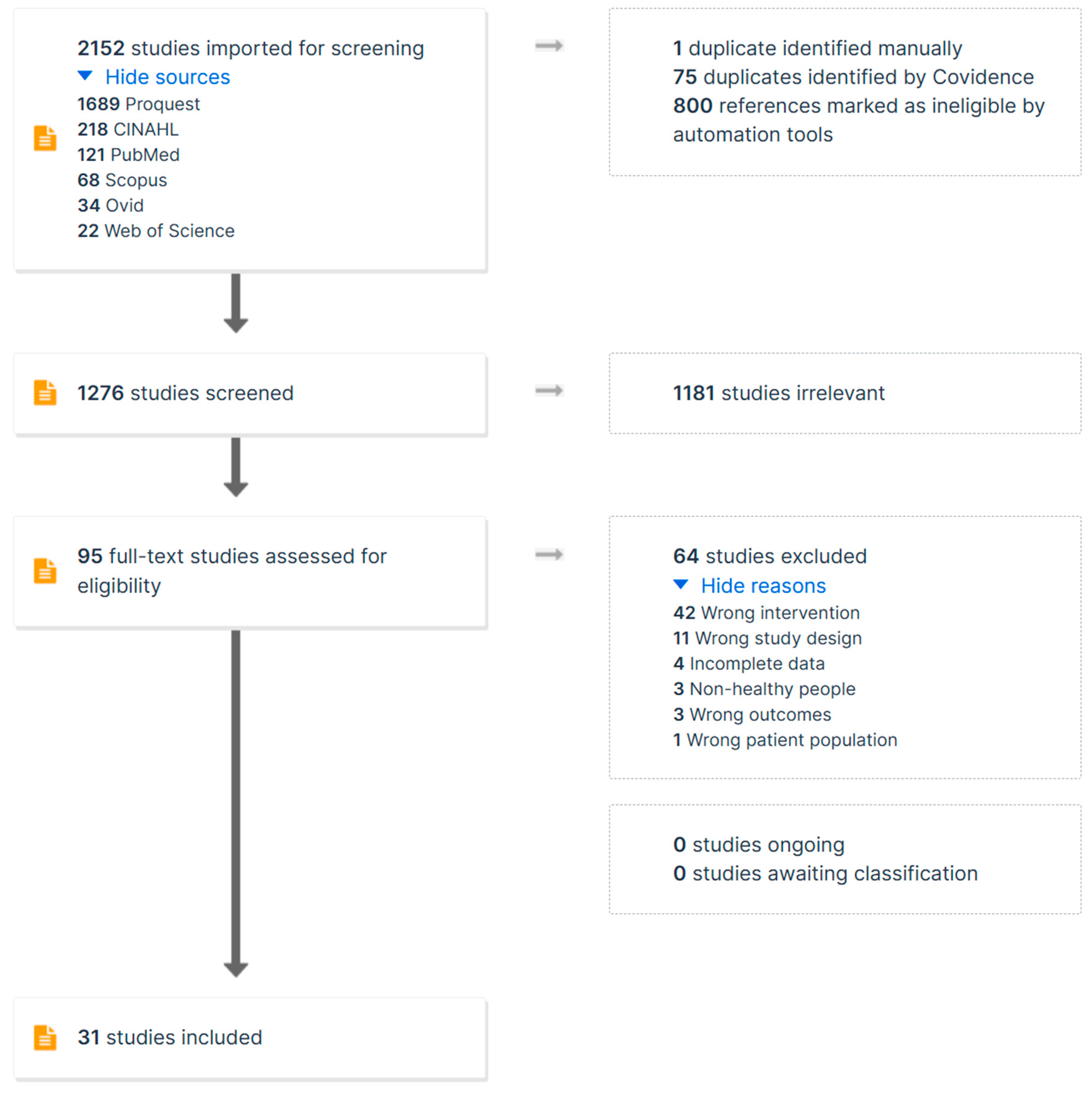
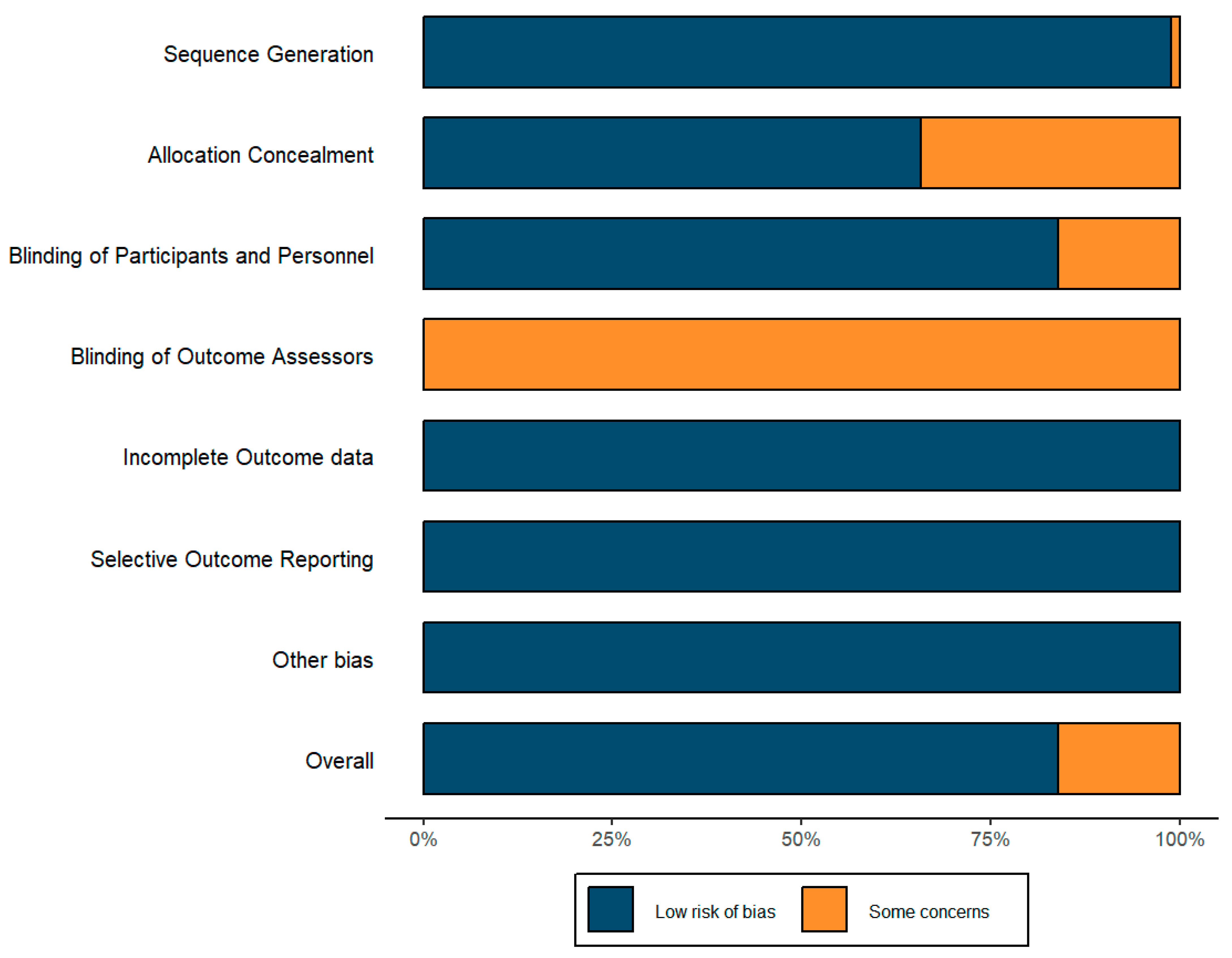
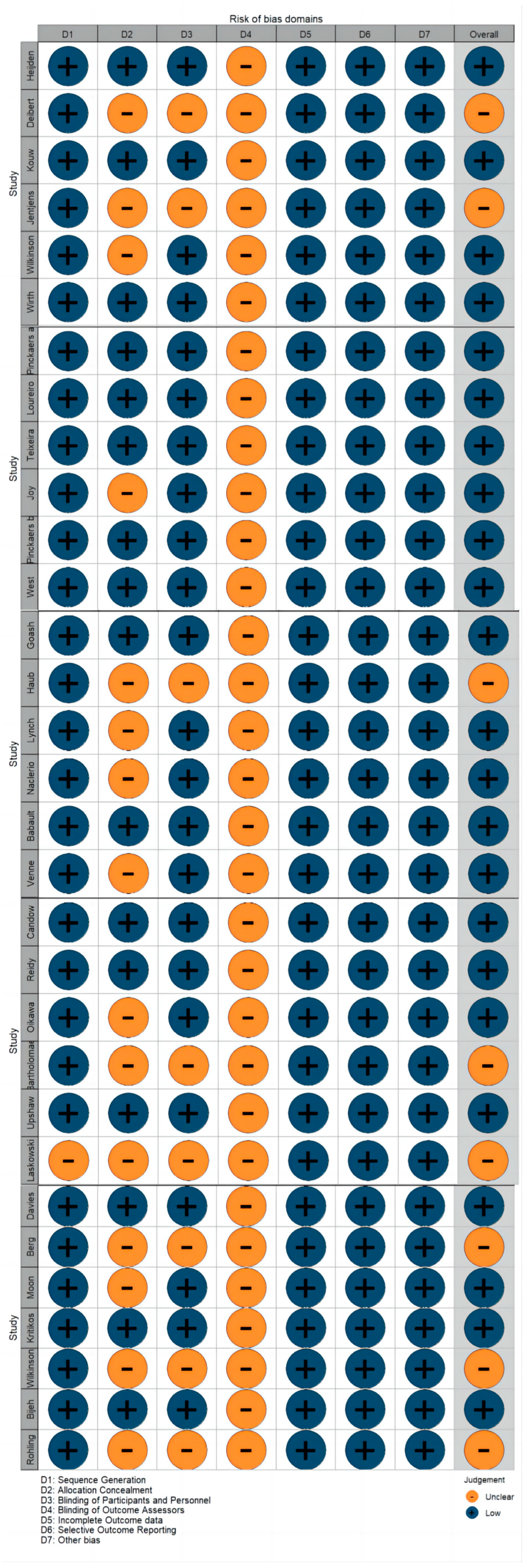
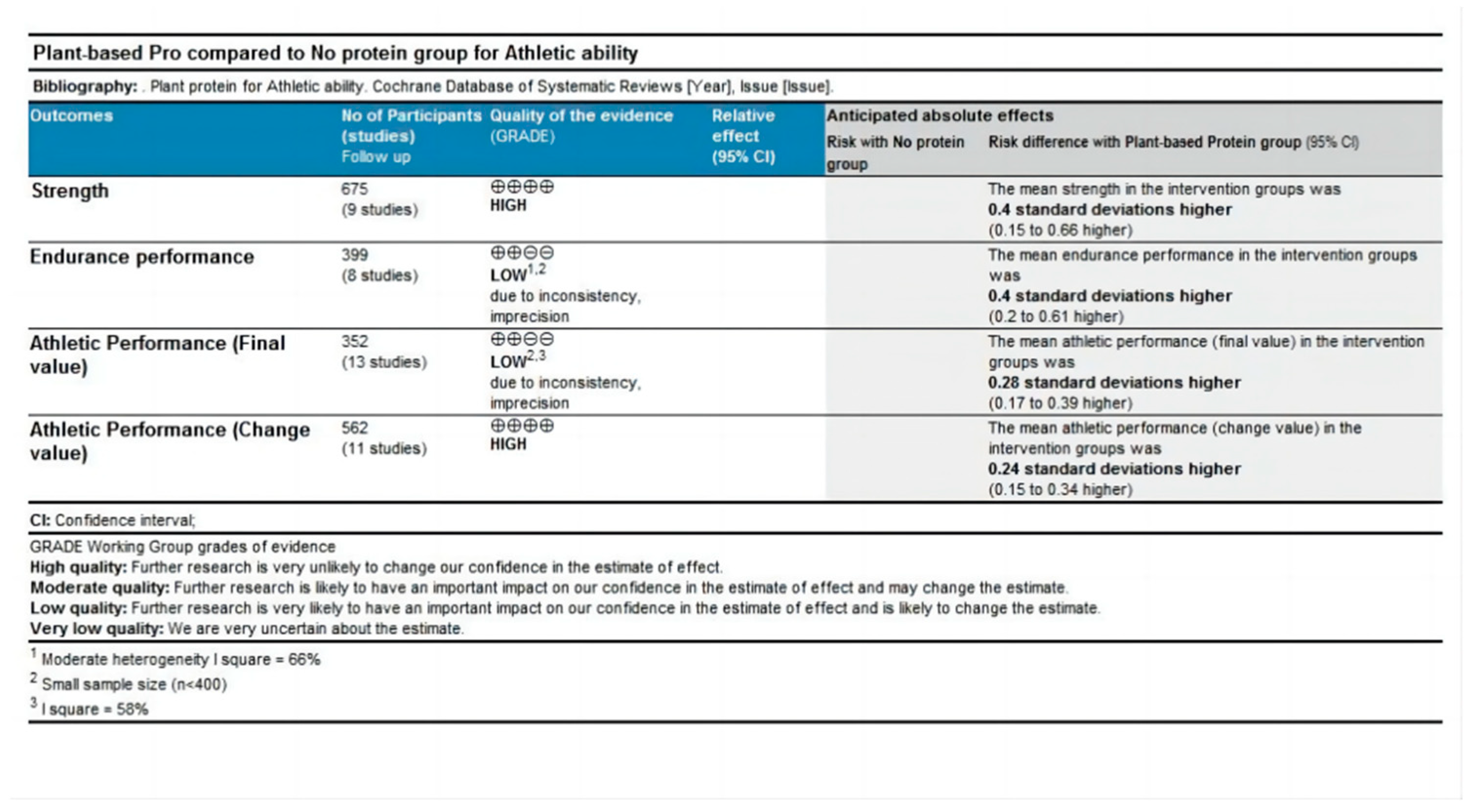
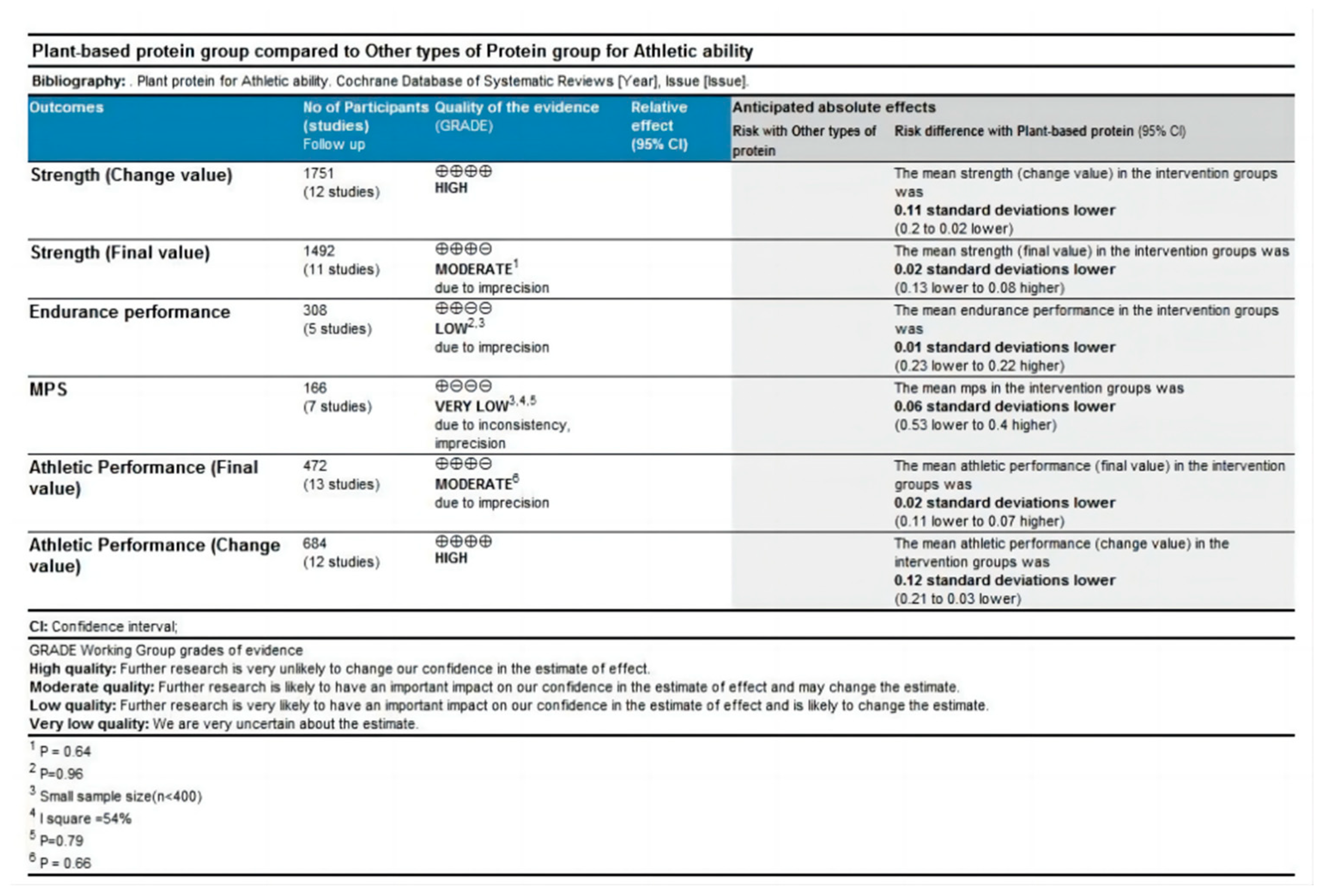
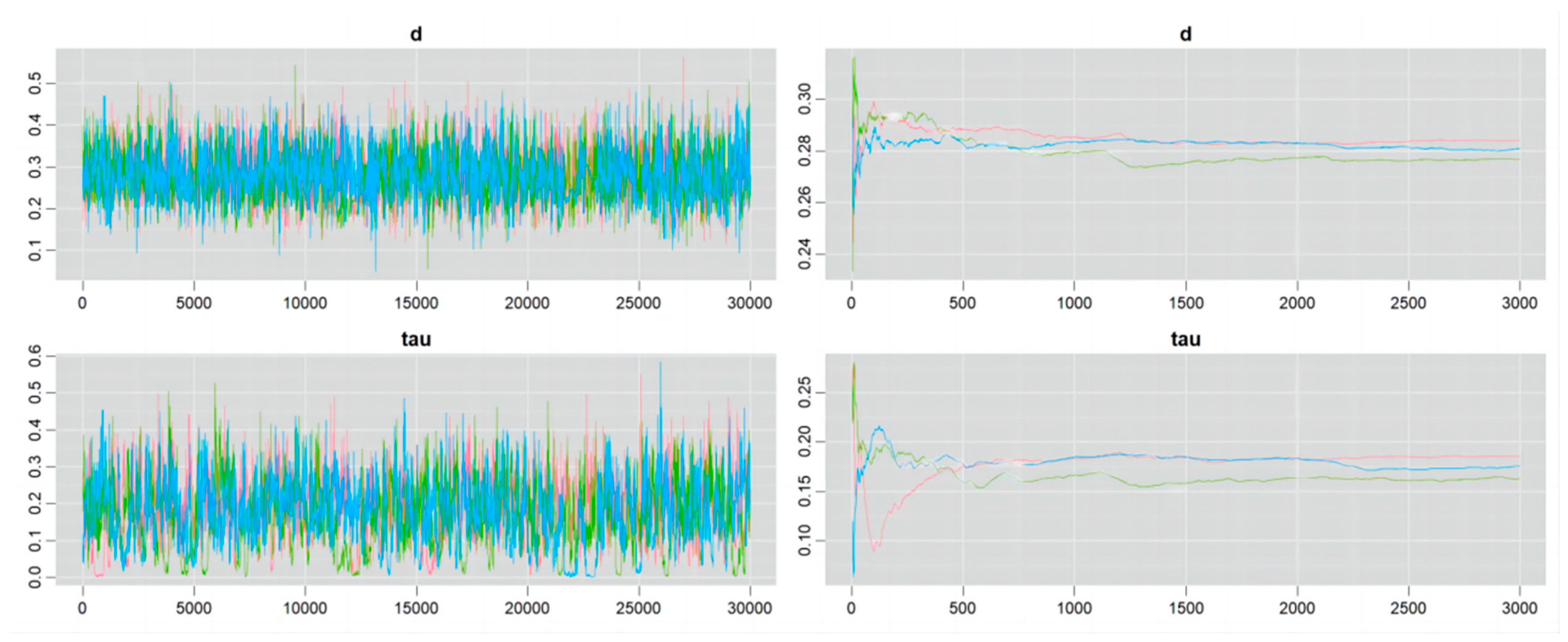
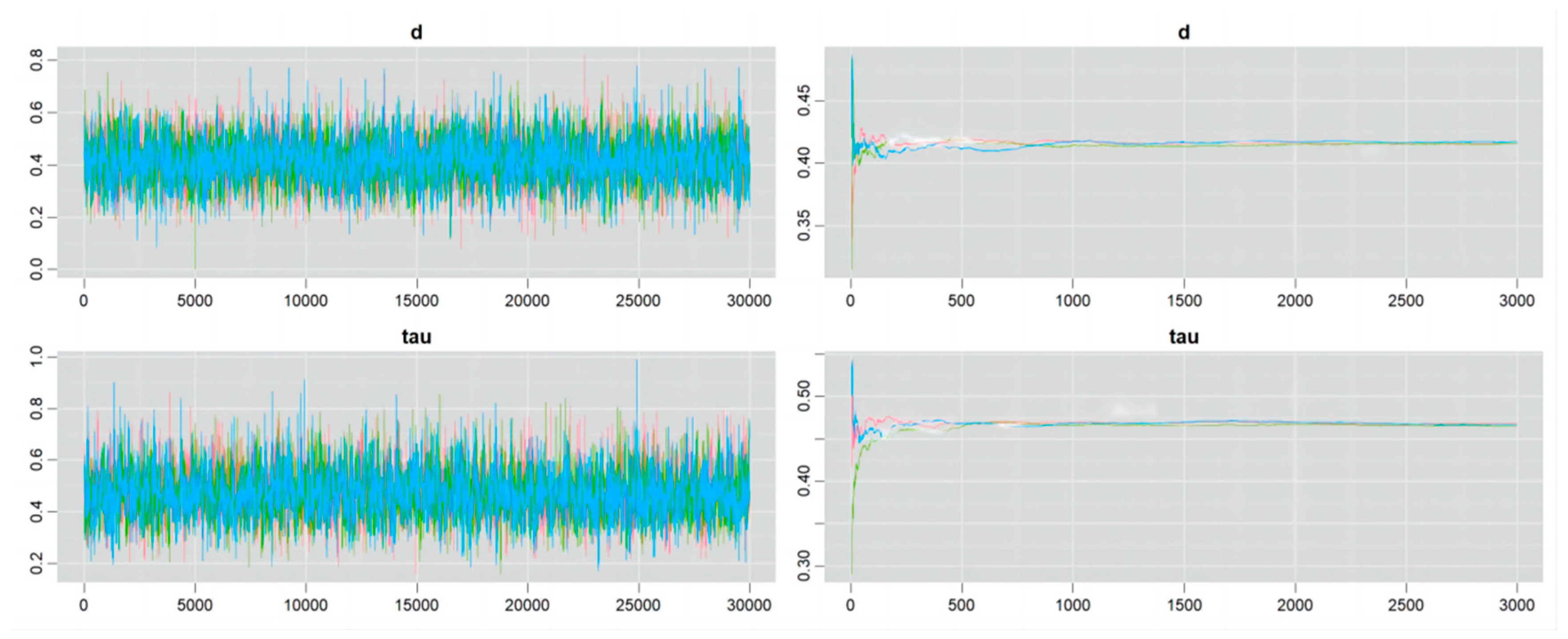
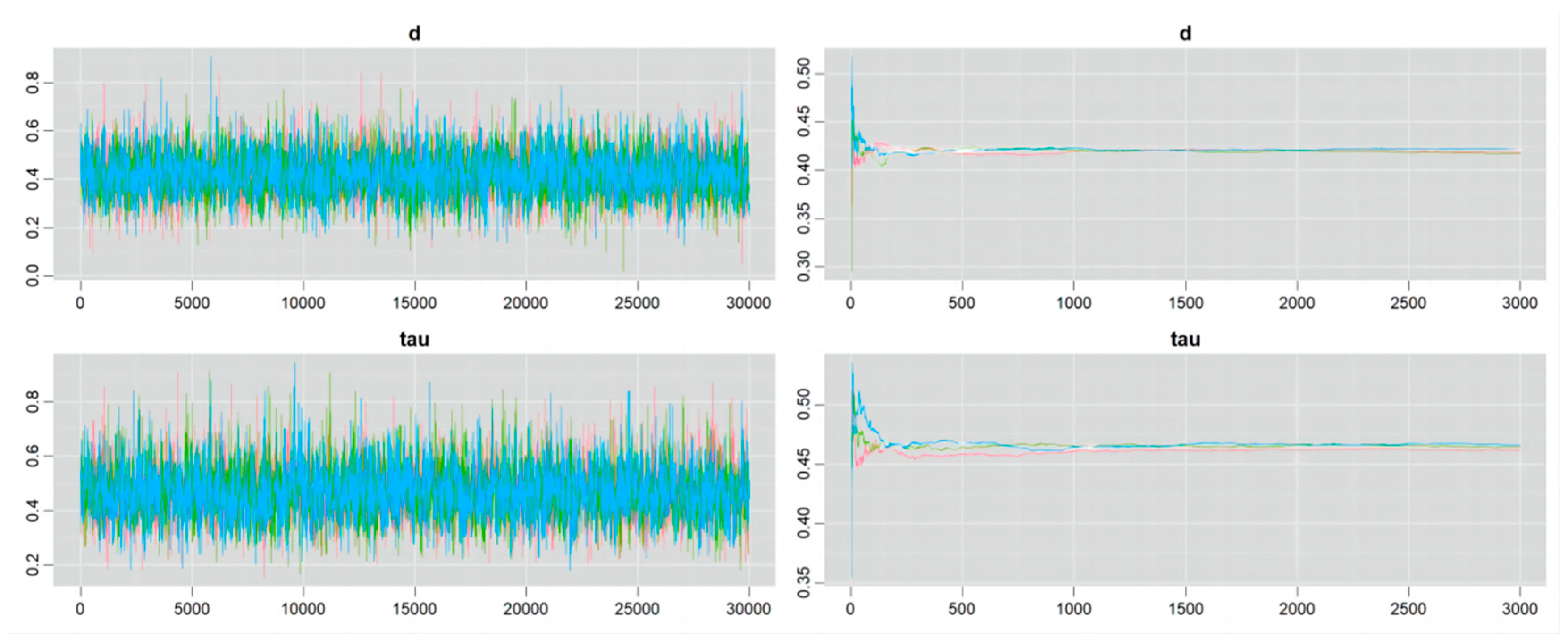
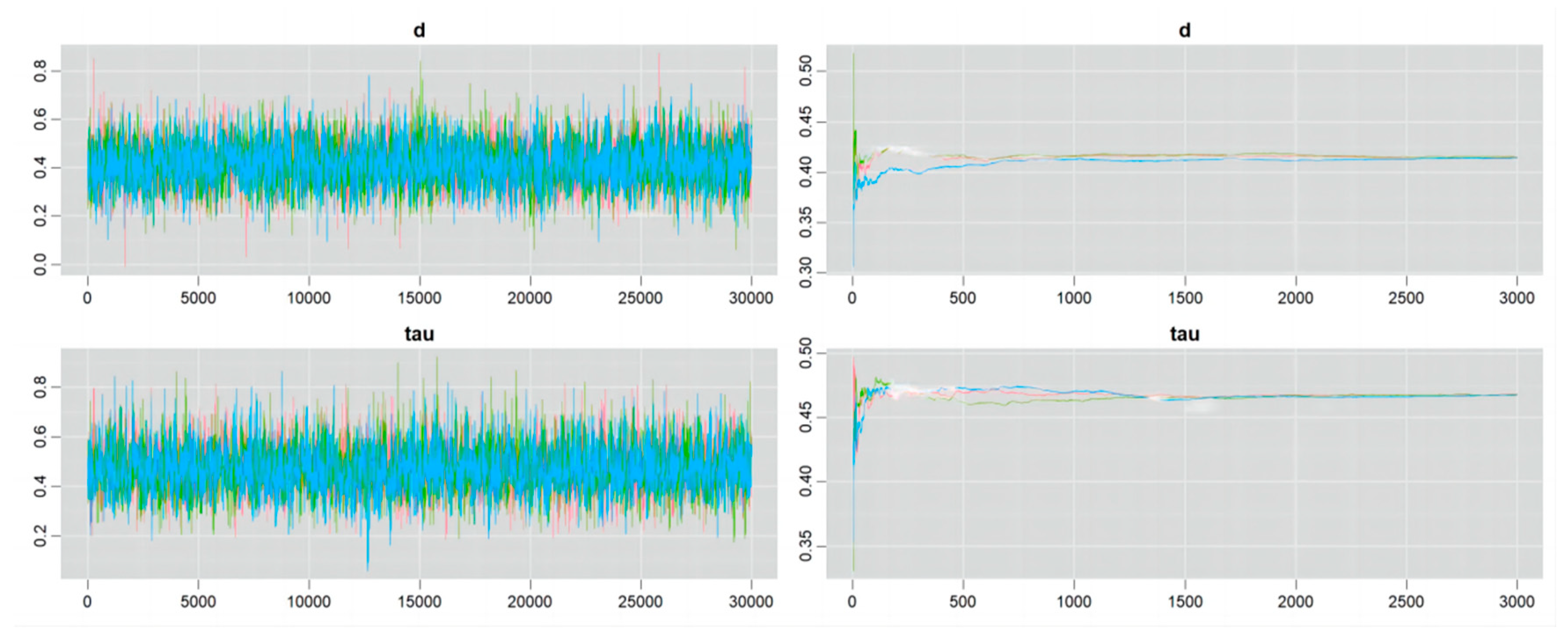
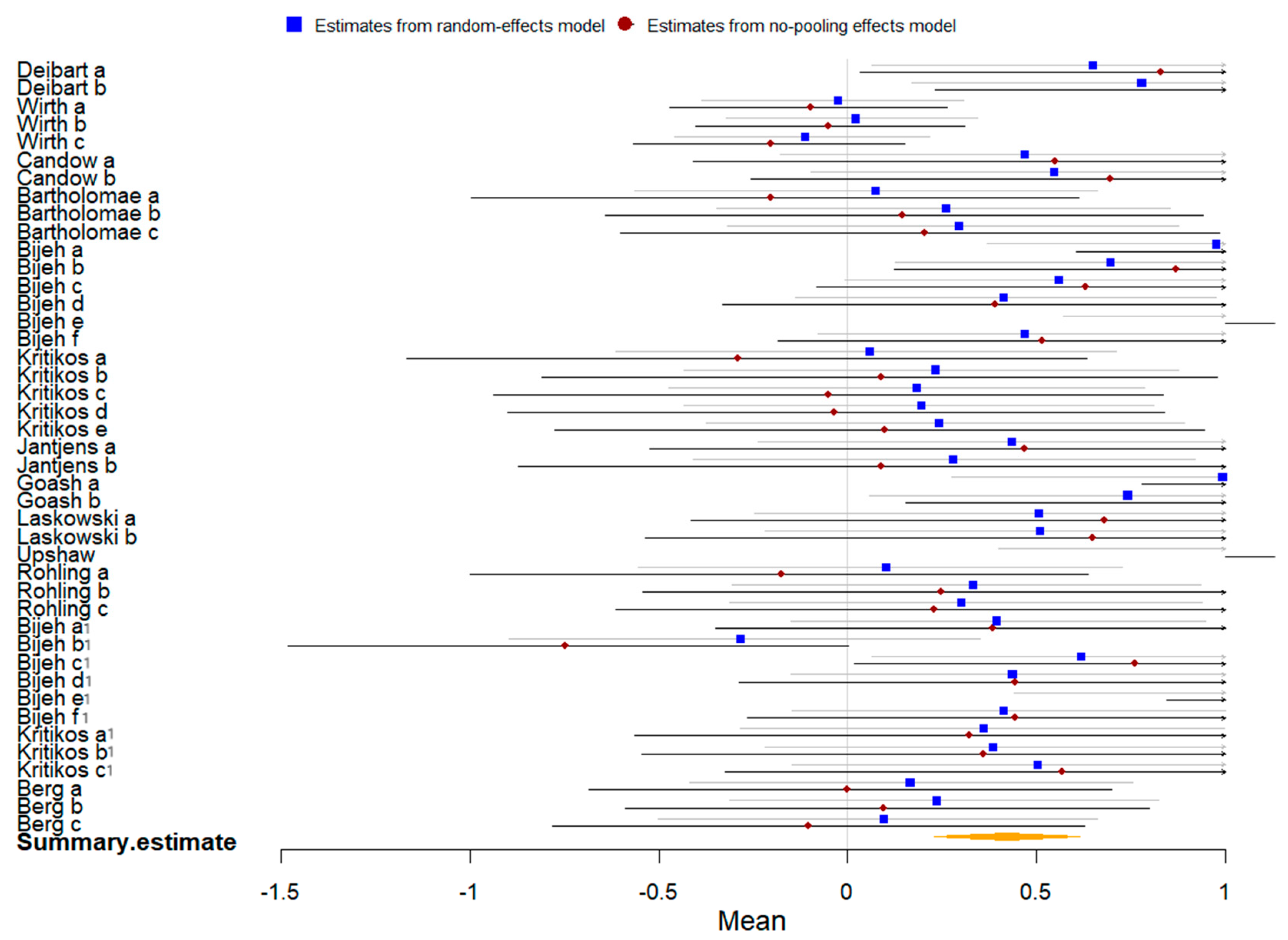
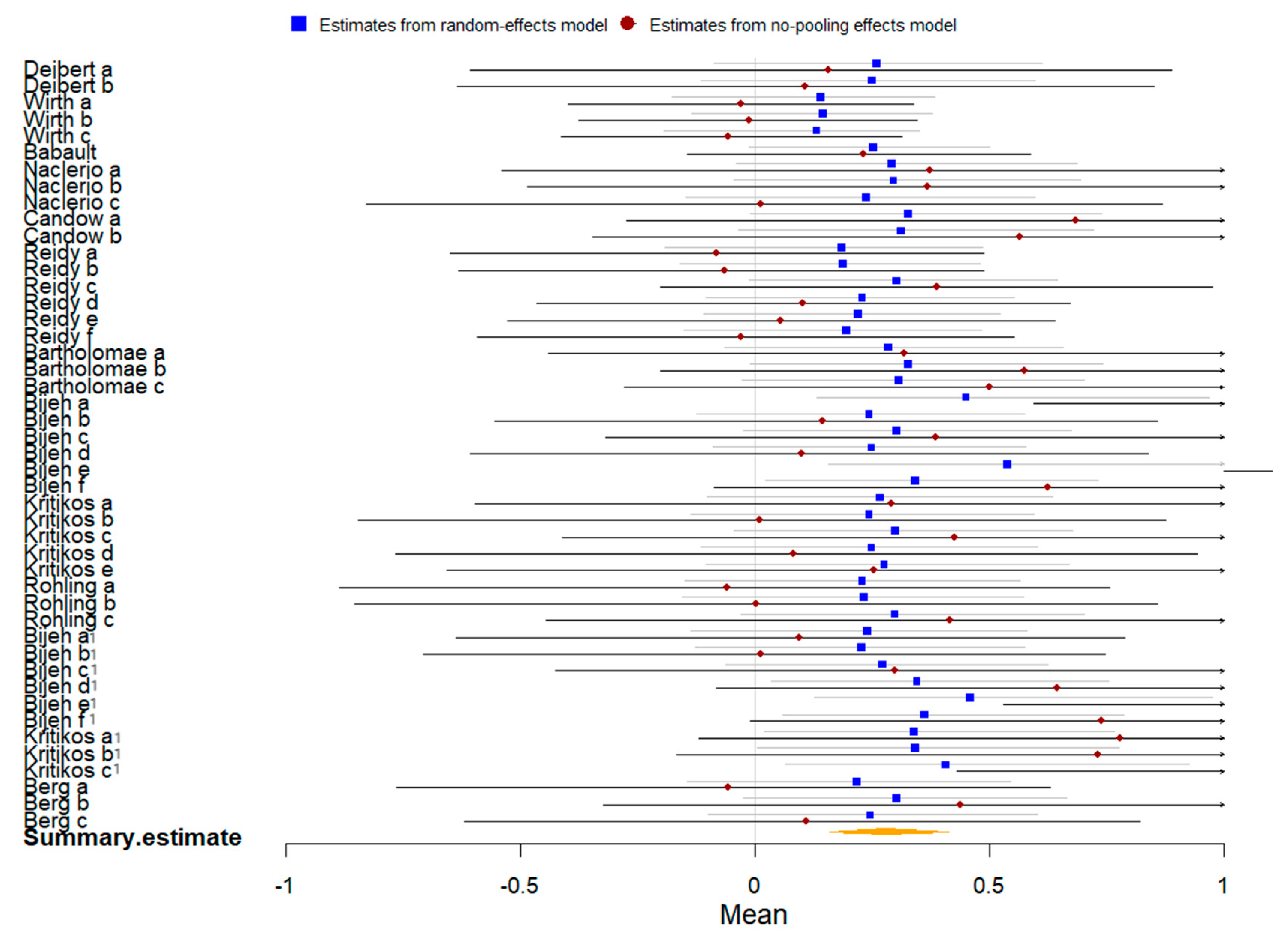

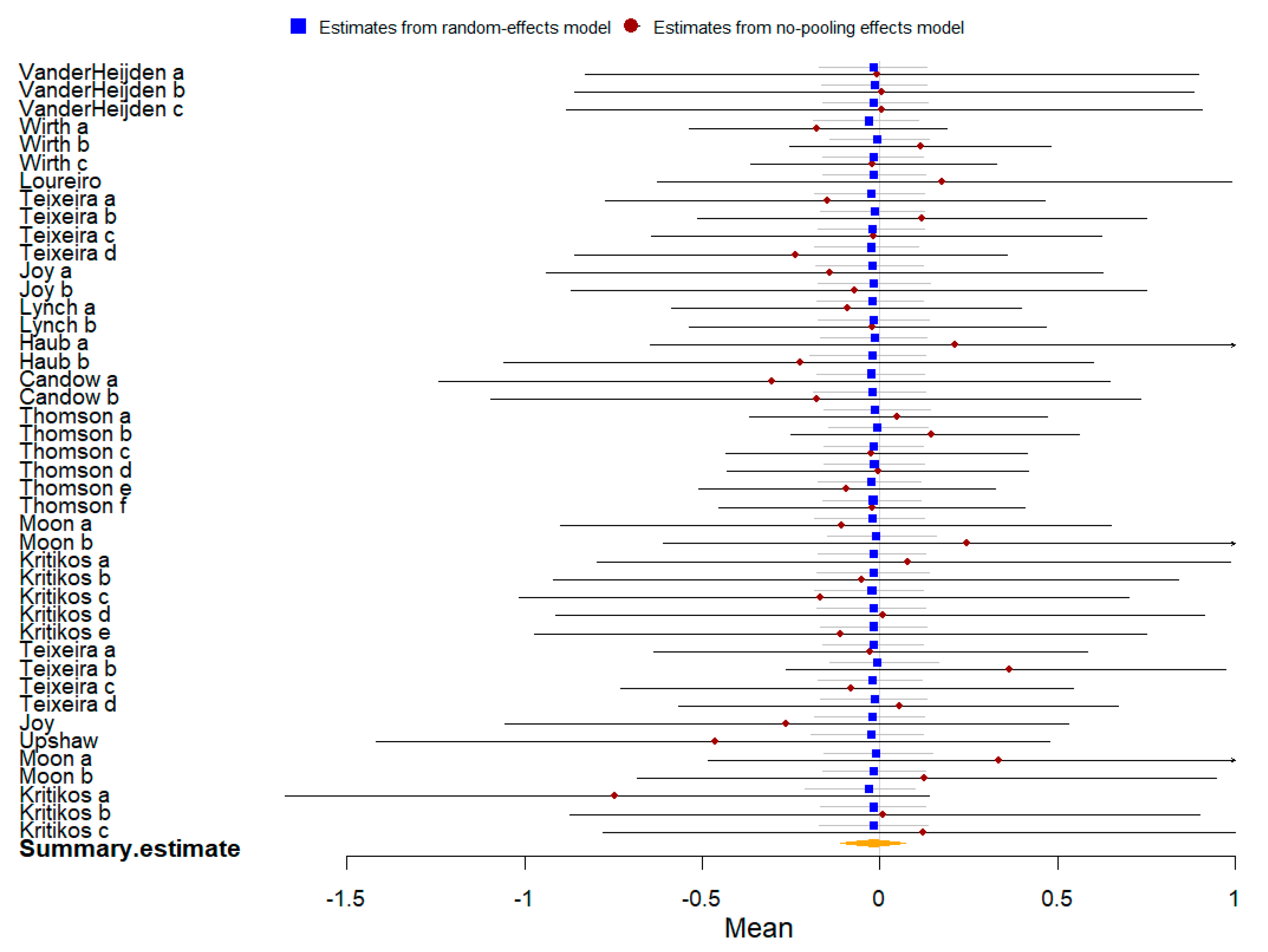

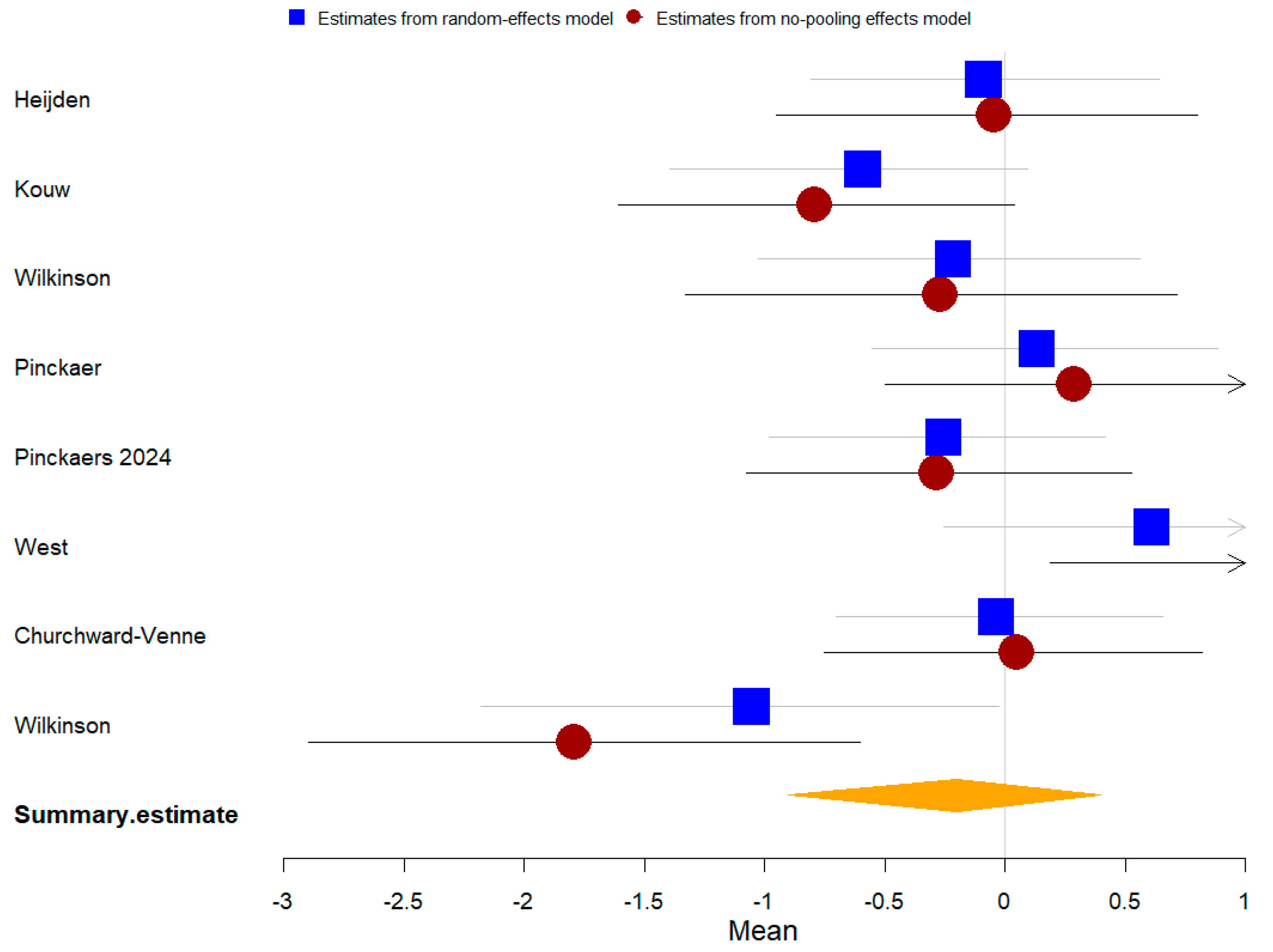
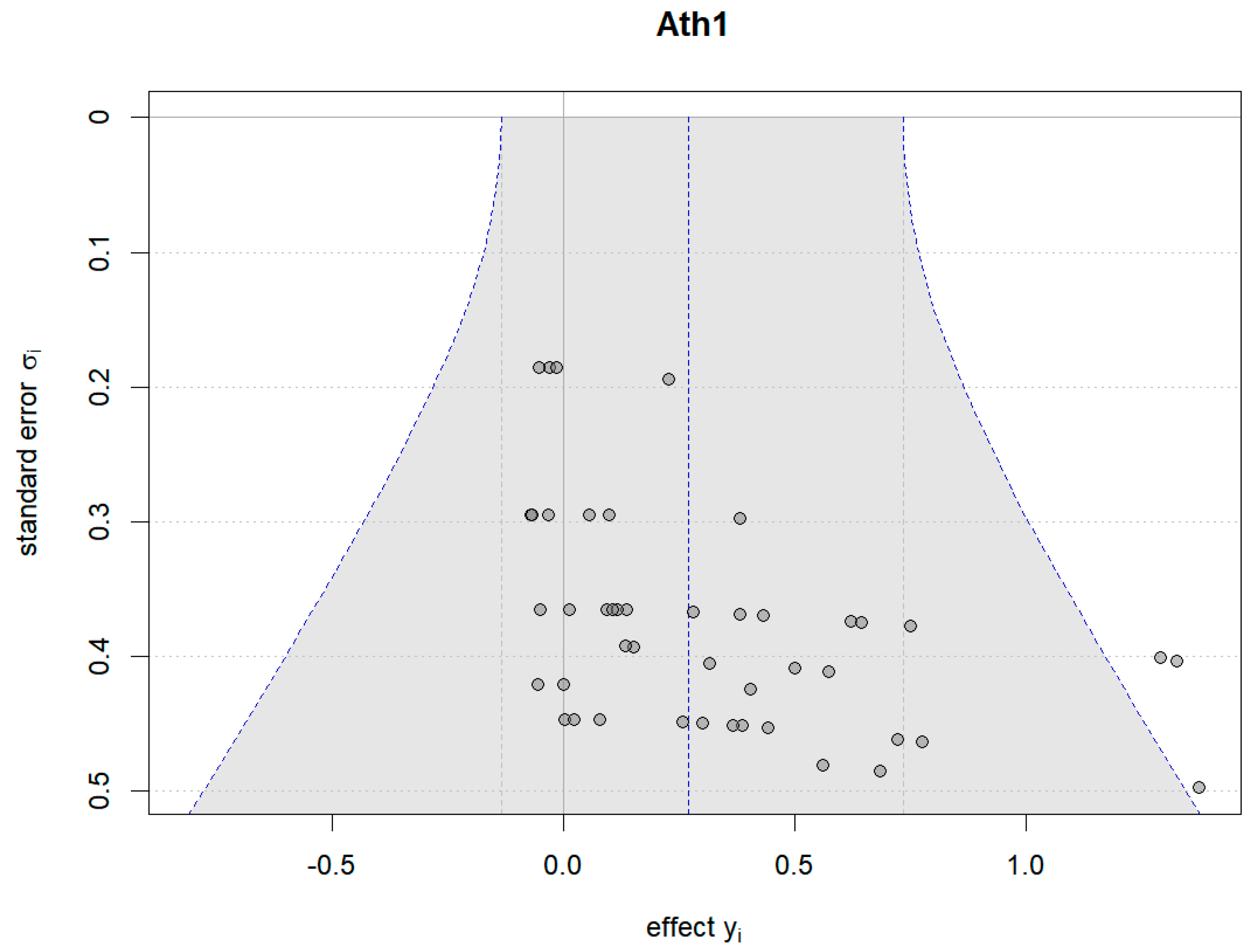
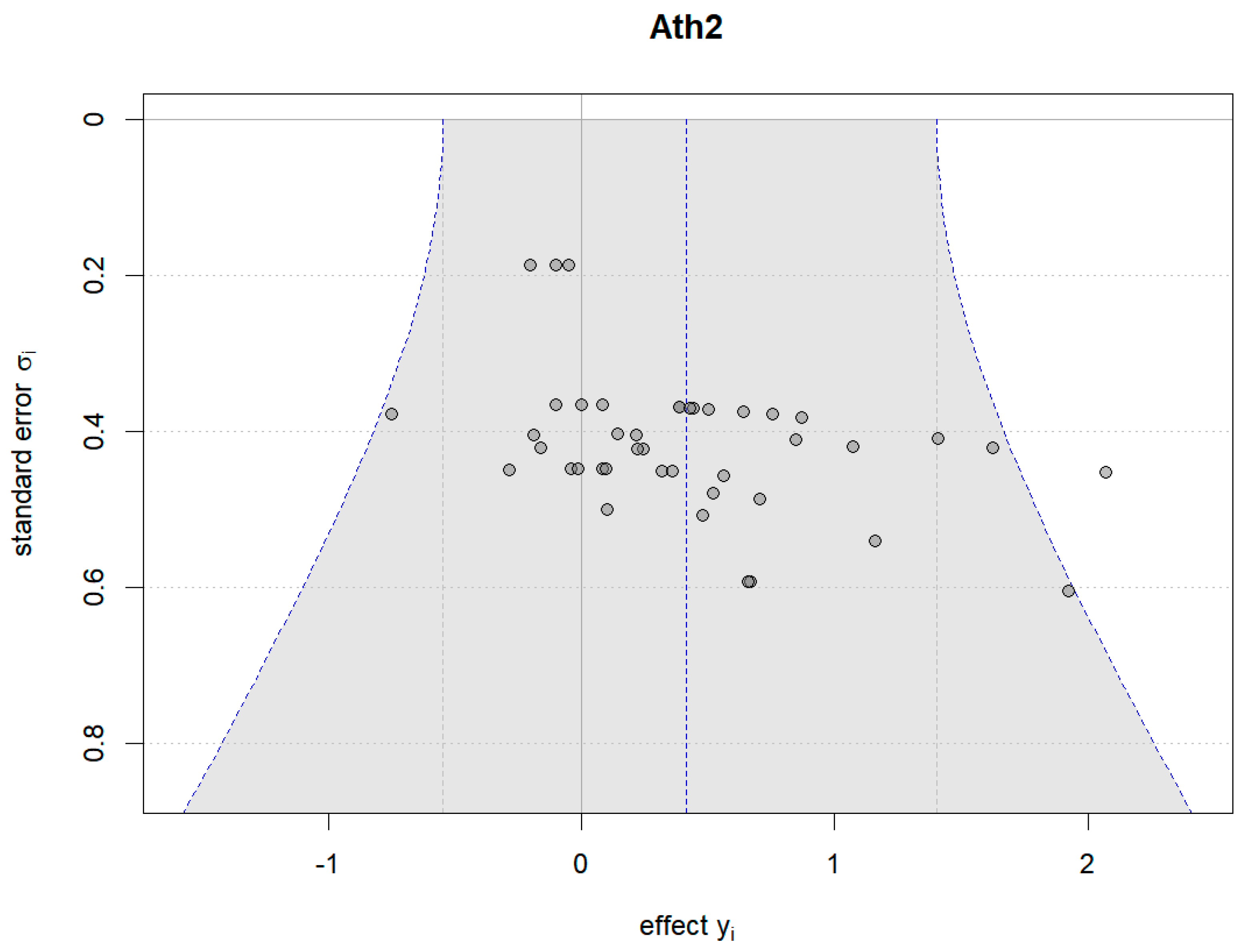
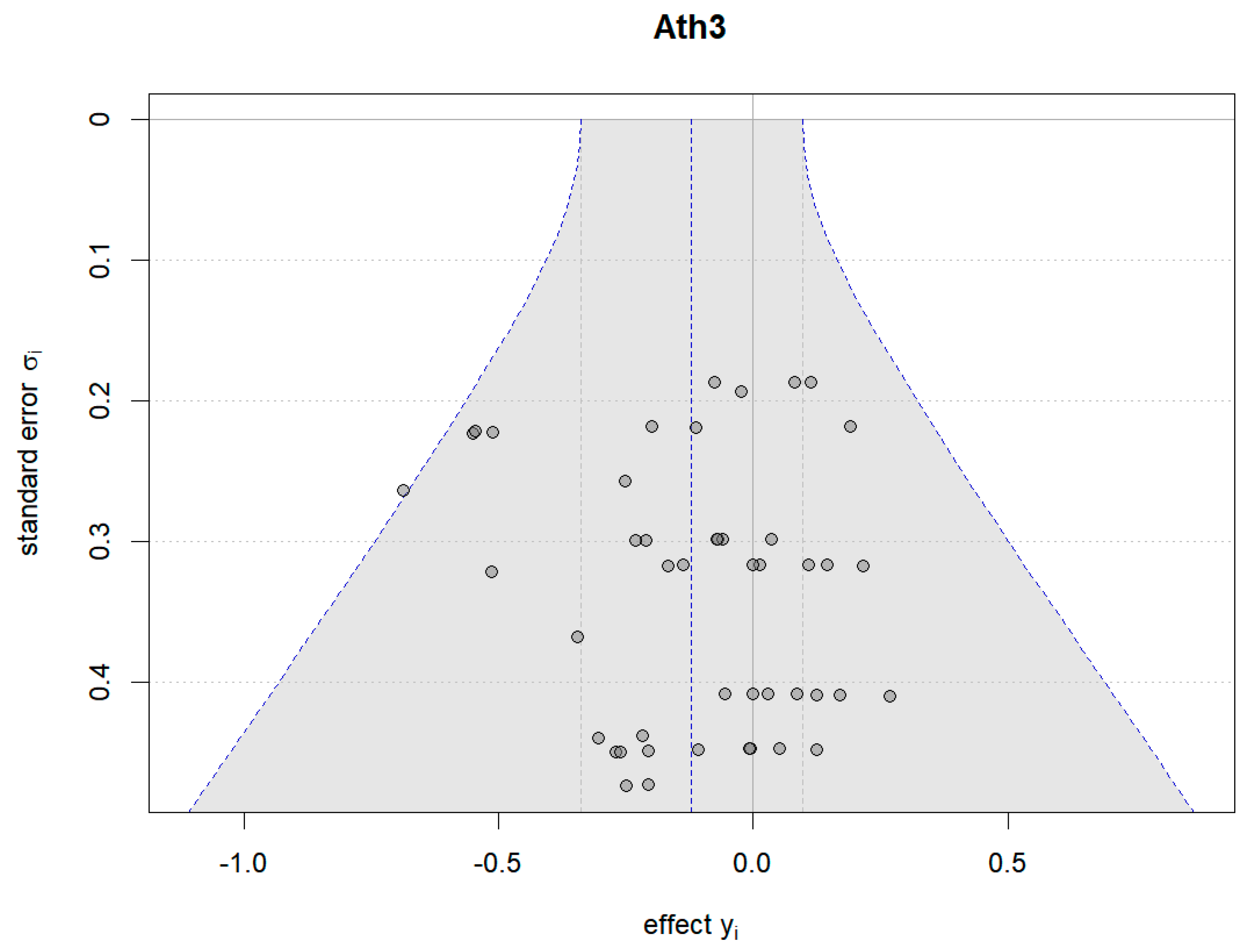
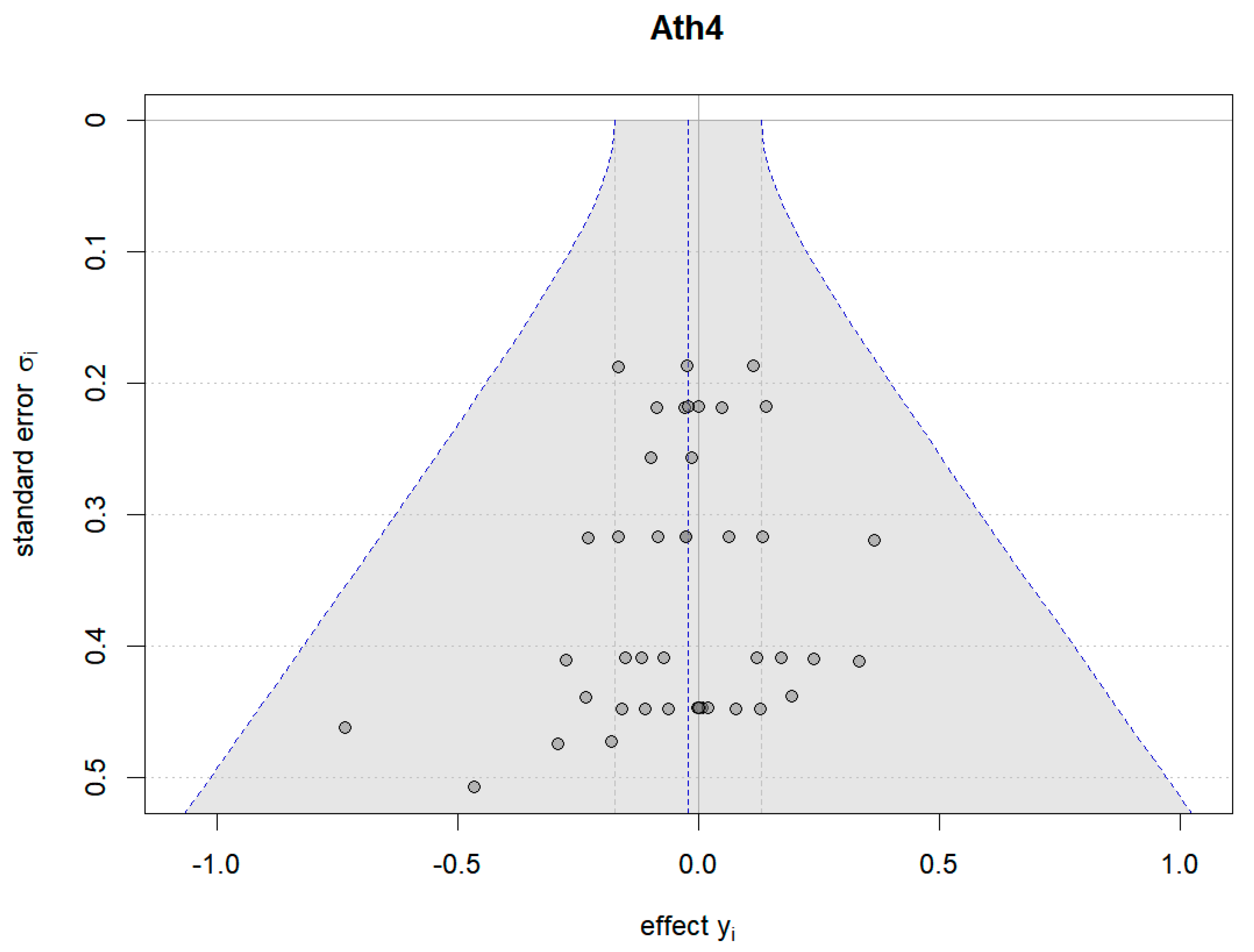
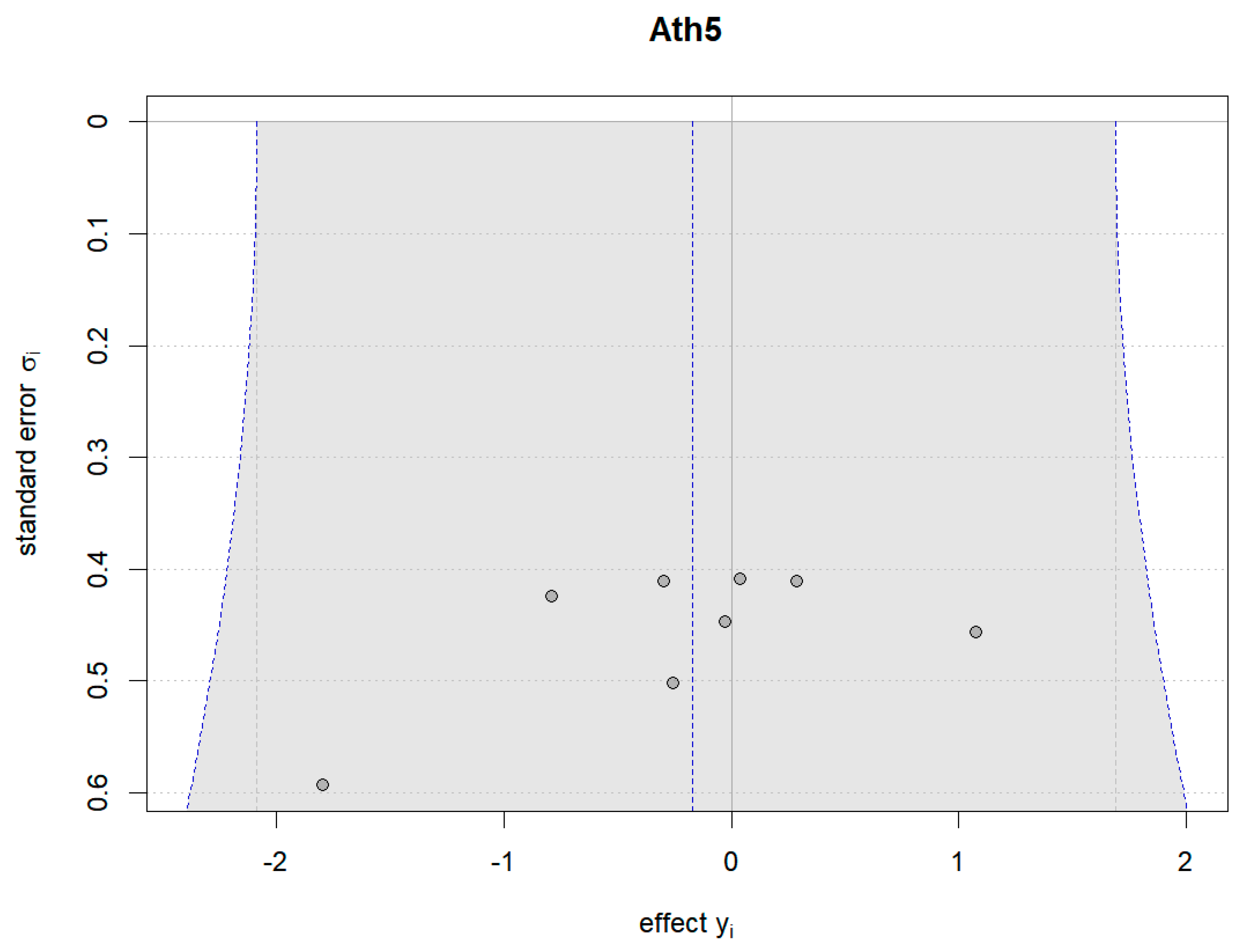
| Code | Study | Years | Country | Study Design | Participants | Age (M ± SD) | BMI (M ± SD) |
|---|---|---|---|---|---|---|---|
| 1 | Deibert | 2011 | Germany | RCT (Parallel) | 40 (40 M/0 F) | 55.7 ± 4.4 | 27.8 ± 2.2 |
| 2 | Kouw | 2022 | Netherlands | RCT (Parallel) | 24 (24 M/0 F) | 24.5 ± 4.5 | 22.85 ± 2.56 |
| 3 | Heijden | 2024 | United Kingdom | RCT (Crossover) | 10 (8 M/2 F) | 26 ± 6 | 24 ± 3 |
| 4 | Jentjens | 2001 | United Kingdom | RCT (Crossover) | 8 (8 M/0 F) | 27.1 ± 7.35 | NA |
| 5 | Wilkinson | 2007 | Canada | RCT (Crossover) | 8 (8 M/0 F) | 21.6 ± 0.85 | NA |
| 6 | Wirth | 2024 | Ireland | RCT (Parallel) | 113 (71 M/42 F) | 59.2 ± 7.7 | 26.2 ± 4.9 |
| 7 | Pinckaers | 2022 | Netherlands | RCT (Parallel) | 24 (24 M/0 F) | 24 ± 4 | 25.2 ± 3 |
| 8 | Loureiro | 2023 | Brazil | RCT (Crossover) | 12 (12 M/0 F) | NA | NA |
| 9 | Teixeira | 2022 | Portugal | RCT (Parallel) | 40 (40 M/0 F) | NA | NA |
| 10 | Joy | 2013 | United States | RCT (Parallel) | 24 (24 M/0 F) | 21.3 ± 1.9 | NA |
| 11 | Pinckaers | 2024 | Netherlands | RCT (Parallel) | 36 (36 M/0 F) | 26 ± 4 | 23 ± 1.93 |
| 12 | West | 2023 | United States | RCT (Parallel) | 33 (24 M/9 F) | 21 ± 1 | 24 ± 1 |
| 13 | Ghosh | 2010 | Malaysia | RCT (Crossover) | 8 (8 M/0 F) | 21.5 ± 1.1 | NA |
| 14 | Lynch | 2020 | United States | RCT (Parallel) | 61 (19 M/42 F) | NA | NA |
| 15 | Naclerio | 2021 | United Kingdom | RCT (Crossover) | 10 (10 M/0 F) | 26.8 ± 1.9 | 25.6 ± 4 |
| 16 | Babault | 2015 | France | RCT (Parallel) | 161 (161 M/0 F) | 22 ± 3.5 | 23 ± 3 |
| 17 | Haub | 2005 | United States | RCT (Parallel) | 21 (21 M/0 F) | 65 ± 5 | 28.2 ± 2.6 |
| 18 | Churchward-Venne | 2019 | Netherlands | RCT (Parallel) | 36 (36 M/0 F) | 23 ± 0.4 | NA |
| 19 | Candow | 2006 | Canada | RCT (Parallel) | 24 (9 M/18 F) | NA | NA |
| 20 | Oikawa | 2020 | Canada | RCT (Parallel) | 24 (0 M/24 F) | 21 ± 3 | NA |
| 21 | Bartholomae | 2019 | United States | RCT (Parallel) | 25 (2 M/23 F) | 31.2 ± 9.2 | 24 ± 4.7 |
| 22 | Reidy | 2016 | United States | RCT (Parallel) | 68 (68 M/0 F) | NA | 25 ± 0.5 |
| 23 | Davies | 2022 | United Kingdom | RCT (Parallel) | 16 (8 M/8 F) | 25 ± 4 | NA |
| 24 | Laskowski | 2003 | Poland | RCT (Parallel) | 12 (NA) | 16.83 ± 0.98 | NA |
| 25 | Upshaw | 2016 | Canada | RCT (Crossover) | 8 (8 M/0 F) | 21.8 ± 2.3 | 24.5 ± 2.6 |
| 26 | Röhling | 2021 | United Kingdom | RCT (Parallel) | 21 (16 M/7 F) | 29 ± 10 | 23 ± 1.7 |
| 27 | Bijeh | 2022 | Iran | RCT (Parallel) | 60 (60 M/0 F) | 66.53 ± 3.16 | NA |
| 28 | Thomson | 2016 | Australia | RCT (Parallel) | 125 (NA) | 61.7 ± 7.9 | 27.5 ± 3.7 |
| 29 | Moon | 2020 | United States | RCT (Parallel) | 24 (24 M/0 F) | 32.8 ± 6.7 | 27.2 ± 1.9 |
| 30 | Berg | 2012 | Germany | RCT (Parallel) | 30 (20 M/10 F) | 24 ± 2 | NA |
| 31 | Kritikos | 2021 | Greece | RCT (Crossover) | 10 (10 M/0 F) | 21 ± 1.5 | 24.6 ± 1.2 |
| Code | Study | Years | Plant-Based Protein Type | Plant-Based Protein Intake | Duration | Extracted Data |
|---|---|---|---|---|---|---|
| 1 | Deibert | 2011 | Soy Protein | 26.7 g per Serving | 12 weeks | Muscle Strength Test |
| 2 | Kouw | 2022 | Plant-based Protein Composed of Wheat and Chickpea flour | 40 g per Serving | NA | Myofibrillar Synthesis Rate |
| 3 | Heijden | 2024 | MyProtein Protein beverage (39.5% pea protein, 39% brown rice protein and 21.0% canola protein) | 32 g per Serving | 5.5 ± 2.5 Weeks | Muscle Strength Test; Myofibrillar Synthesis Rate |
| 4 | Jentjens | 2001 | Wheat Protein | NA | NA | Endurance Performance Test |
| 5 | Wilkinson | 2007 | Soy Protein | 18.2 g per Serving | ≥1 Week | Myofibrillar Synthesis Rate |
| 6 | Wirth | 2024 | Plant-based Protein Composed of Pea and Rice Protein Mixture | 23 g per day | 12 Weeks | Muscle Strength Test |
| 7 | Pinckaers | 2022 | Potato Protein | 30 g per serving | NA | Myofibrillar Synthesis Rate |
| 8 | Loureiro | 2023 | Pea Protein | 0.5 g/kg | 26 Days | Muscle Strength Test |
| 9 | Teixeira | 2022 | Pea Protein | NA | 8 Weeks | Muscle Strength Test; Endurance Performance Test |
| 10 | Joy | 2013 | Rice Protein | 48 g per Serving | 8 Weeks | Muscle Strength Test; Endurance Performance Test |
| 11 | Pinckaers | 2024 | Corn Protein | 30 g per Serving | NA | Myofibrillar Synthesis Rate |
| 12 | West | 2023 | Pea Protein | NA | NA | Myofibrillar Synthesis Rate |
| 13 | Ghosh | 2010 | Soy Protein | 5 g per serving | NA | Endurance Performance Test |
| 14 | Lynch | 2020 | Soy Protein | 26 g per day | 12 Weeks | Muscle Strength Test |
| 15 | Naclerio | 2021 | Vegan-protein | 30 g Per Serving | 4 Weeks | Muscle Strength Test |
| 16 | Babault | 2015 | Pea Protein | 25 g Per Serving | 17 Weeks | Muscle Strength Test |
| 17 | Haub | 2005 | Soy Protein | 0.6 g/kg | 14 Weeks | Muscle Strength Test |
| 18 | Churchward-Venne | 2019 | Soy Protein | 20 g Per Serving | NA | Myofibrillar Synthesis Rate |
| 19 | Candow | 2006 | Soy Protein | 1.2 g/kg | 6 Weeks | Muscle Strength Test |
| 20 | Oikawa | 2020 | Potato Protein | 25 g per day | NA | Myofibrillar Synthesis Rate |
| 21 | Bartholomae | 2019 | Mung Bean Protein | 18 g per day | 8 Weeks | Muscle Strength Test |
| 22 | Reidy | 2016 | Soy Protein | 22 g per serving | 12 Weeks | Muscle Strength Test |
| 23 | Davies | 2022 | Fava Bean Protein | 0.33 g/kg | NA | Myofibrillar Synthesis Rate |
| 24 | Laskowski | 2003 | Soy Protein | 0.5 g/kg | 4 weeks | Endurance Performance Test |
| 25 | Upshaw | 2016 | Soy Protein | 20.1 ± 2.5 g per serving | 5 weeks | Endurance Performance Test |
| 26 | Röhling | 2021 | Soy Protein | 27.2 g per Serving | 12 weeks | Endurance Performance Test |
| 27 | Bijeh | 2022 | Soy Protein | 6.75 g per serving | 12 weeks | Muscle Strength Test; Endurance Performance Test |
| 28 | Thomson | 2016 | Soy Protein | 1.2 g/kg | 12 weeks | Muscle Strength Test |
| 29 | Moon | 2020 | Soy protein | 24 g per serving | 8 weeks | Muscle Strength Test; Endurance Performance Test |
| 30 | Berg | 2012 | Soy protein | 53.3 g per serving | 6 weeks | Endurance Performance Test |
| 31 | Kritikos | 2021 | Soy protein | 1 g/kg per day | 4 weeks | Muscle Strength Test; Endurance Performance Test |
| Results from Bayesian Meta-Analysis | Results from Trational Frequentist Meta-Analysis | |||||||||||||
|---|---|---|---|---|---|---|---|---|---|---|---|---|---|---|
| Outcome | Intervention | Comparison | Mu.vect(SMD) | Sd.vect | 95%CI | Rhat | Tau | 95%CI | DIC | SMD | 95%CI | I2 | p | Z |
| Athletic Performance (Change Value) | Plant-based Protein | No protein | 0.281 | 0.065 | 0.159–0.412 | 1.001 | 0.18 | 0.017–0.362 | 77.3 | 0.24 | 0.15–0.34 | 24% | 0.00001 | 4.85 |
| Athletic Performance (Final Value) | 0.418 | 0.098 | 0.229–0.611 | 1.001 | 0.467 | 0.283–0.684 | 103.2 | 0.28 | 0.17–0.39 | 58% | 0.00001 | 4.9 | ||
| Results from Bayesian Meta-Analysis | Results from Trational Frequentist Meta-Analysis | |||||||||||||
|---|---|---|---|---|---|---|---|---|---|---|---|---|---|---|
| Outcome | Intervention | Comparison | Mu.vect(SMD) | Sd.vect | 95%CI | Rhat | Tau | 95%CI | DIC | SMD | 95%CI | I2 | p | Z |
| Athletic Performance (Change Value) | Plant-based Protein | Other Types of Protein Ingestion | −0.119 | 0.047 | −0.209 to −0.028 | 1.003 | 0.076 | 0.003–0.192 | 16.2 | −0.12 | −0.21 to −0.03 | 0% | 0.006 | 2.76 |
| Athletic Performance (Final Value) | −0.021 | 0.049 | −0.118 to 0.072 | 1.003 | 0.046 | 0.001–0.128 | 1.8 | −0.02 | −0.11 to 0.07 | 0% | 0.66 | 0.44 | ||
| MPS | −0.177 | 0.343 | −0.866 to 0.491 | 1.001 | 0.743 | 0.116–1.704 | 22 | −0.06 | −0.53 to 0.4 | 54% | 0.79 | 0.26 | ||
| Results from Bayesian Meta-Analysis | Results from Trational Frequentist Meta-Analysis | |||||||||||||
|---|---|---|---|---|---|---|---|---|---|---|---|---|---|---|
| Outcome | Intervention | Comparison | Mu.vect(SMD) | Sd.vect | 95%CI | Rhat | Tau | 95%CI | DIC | SMD | 95%CI | I2 | p | Z |
| Muscle strength (Change value) | Plant-based Protein | No protein | 0.225 | 0.073 | 0.091–0.379 | 1.002 | 0.162 | 0.008–0.372 | 46.2 | 0.19 | 0.08–0.31 | 23% | 0.0008 | 3.35 |
| Muscle strength (Final value) | 0.372 | 0.138 | 0.115–0.652 | 1.001 | 0.471 | 0.244–0.772 | 41 | 0.4 | 0.15–0.66 | 59% | 0.002 | 3.07 | ||
| Endurance performance (Change value) | 0.415 | 0.124 | 0.178–0.660 | 1.001 | 0.222 | 0.01–0.564 | 23 | 0.4 | 0.2–0.61 | 17% | 0.0001 | 3.93 | ||
| Endurance performance (Final value) | 0.479 | 0.154 | 0.187–0.801 | 1.001 | 0.53 | 0.182–0.940 | 67.2 | 0.5 | 0.2–0.8 | 66% | 0.001 | 3.24 | ||
| Results from Bayesian Meta-Analysis | Results from Trational Frequentist Meta-Analysis | |||||||||||||
|---|---|---|---|---|---|---|---|---|---|---|---|---|---|---|
| Outcome | Intervention | Comparison | Mu.vect(SMD) | Sd.vect | 95%CI | Rhat | Tau | 95%CI | DIC | SMD | 95%CI | I2 | p | Z |
| Muscle strength (Change value) | Plant-based Protein | Other Types of Protein Ingestion | −0.133 | 0.051 | −0.235 to −0.034 | 1.001 | 0.086 | 0.004–0.214 | 13 | −0.11 | −0.2 to −0.02 | 0% | 0.02 | 2.3 |
| Muscle strength (Final value) | −0.024 | 0.052 | −0.125 to 0.08 | 1.002 | 0.049 | 0.002–0.142 | −3.8 | −0.02 | −0.13 to 0.08 | 0% | 0.64 | 0.46 | ||
| Endurance performance (Change value) | −0.051 | 0.134 | −0.312 to 0.216 | 1.001 | 0.153 | 0.006–0.464 | 6.3 | −0.05 | −0.28 to 0.18 | 0% | 0.66 | 0.44 | ||
| Endurance performance (Final value) | −0.013 | 0.133 | −0.275 to 0.243 | 1.002 | 0.158 | 0.007−0.474 | 9.2 | −0.01 | −0.23 to 0.22 | 0% | 0.96 | 0.05 | ||
| Results from Bayesian Meta-Analysis | Results from Trational Frequentist Meta-Analysis | ||||||||||||||
|---|---|---|---|---|---|---|---|---|---|---|---|---|---|---|---|
| Outcome | Participants | Intervention | Comparison | Mu.vect(SMD) | Sd.vect | 95%CI | Rhat | Tau | 95%CI | DIC | SMD | 95%CI | I2 | p | Z |
| Athletic Performance (Change Value) | Older people (Age > 55) | Plant-based Protein | No protein | 0.41 | 0.151 | 0.13–0.722 | 1.001 | 0.478 | 0.214–0.832 | 35.4 | 0.261 | 0.116–0.406 | 64.20% | 0.0001 | 3.52 |
| Athletic Performance (Change Value) | Young people (Age < 55) | 0.244 | 0.074 | 0.1–0.395 | 1.003 | 0.086 | 0.002–0.246 | 19.6 | 0.24 | 0.11–0.379 | 0% | 0.0001 | 3.57 | ||
| Athletic Performance (Final Value) | Older people (Age > 55) | 0.555 | 0.184 | 0.195–0.929 | 1.001 | 0.641 | 0.376–1.030 | 30.3 | 0.311 | 0.164–0.457 | 76.60% | 0.0001 | 4.15 | ||
| Athletic Performance (Final Value) | Young people (Age < 55) | 0.285 | 0.1 | 0.097–0.49 | 1.001 | 0.185 | 0.008–0.518 | 55.1 | 0.269 | 0.095–0.444 | 35.40% | 0.003 | 3.02 | ||
Disclaimer/Publisher’s Note: The statements, opinions and data contained in all publications are solely those of the individual author(s) and contributor(s) and not of MDPI and/or the editor(s). MDPI and/or the editor(s) disclaim responsibility for any injury to people or property resulting from any ideas, methods, instructions or products referred to in the content. |
© 2024 by the authors. Licensee MDPI, Basel, Switzerland. This article is an open access article distributed under the terms and conditions of the Creative Commons Attribution (CC BY) license (https://creativecommons.org/licenses/by/4.0/).
Share and Cite
Zhao, S.; Xu, Y.; Li, J.; Ning, Z. The Effect of Plant-Based Protein Ingestion on Athletic Ability in Healthy People—A Bayesian Meta-Analysis with Systematic Review of Randomized Controlled Trials. Nutrients 2024, 16, 2748. https://doi.org/10.3390/nu16162748
Zhao S, Xu Y, Li J, Ning Z. The Effect of Plant-Based Protein Ingestion on Athletic Ability in Healthy People—A Bayesian Meta-Analysis with Systematic Review of Randomized Controlled Trials. Nutrients. 2024; 16(16):2748. https://doi.org/10.3390/nu16162748
Chicago/Turabian StyleZhao, Shiao, Yipin Xu, Jiarui Li, and Ziheng Ning. 2024. "The Effect of Plant-Based Protein Ingestion on Athletic Ability in Healthy People—A Bayesian Meta-Analysis with Systematic Review of Randomized Controlled Trials" Nutrients 16, no. 16: 2748. https://doi.org/10.3390/nu16162748
APA StyleZhao, S., Xu, Y., Li, J., & Ning, Z. (2024). The Effect of Plant-Based Protein Ingestion on Athletic Ability in Healthy People—A Bayesian Meta-Analysis with Systematic Review of Randomized Controlled Trials. Nutrients, 16(16), 2748. https://doi.org/10.3390/nu16162748






